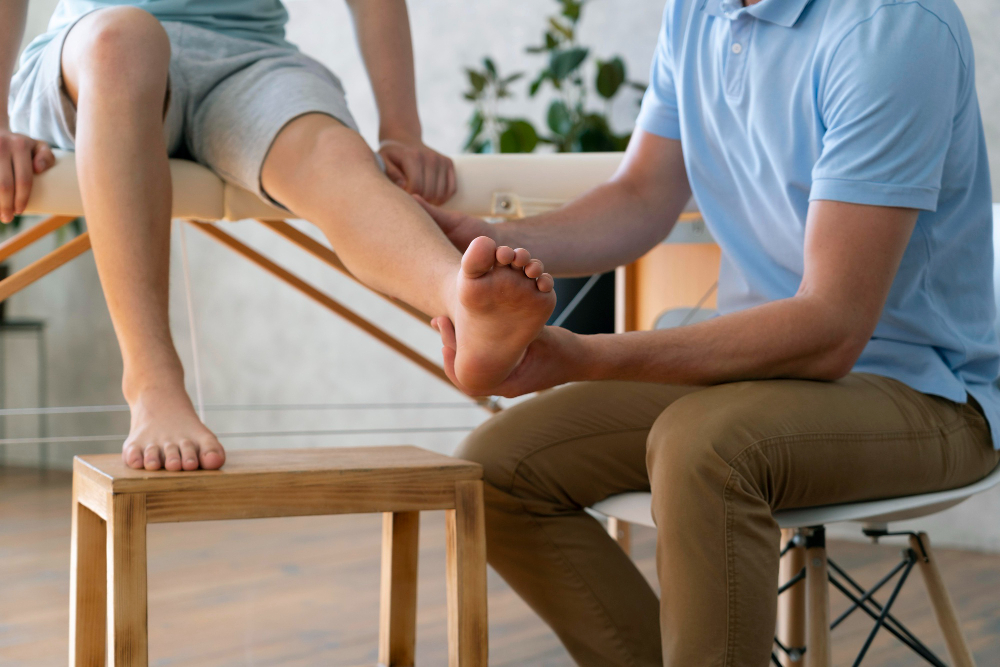Ankle sprain is an injury that occurs when the strong ligaments that support the ankle stretch or tear. It is one of the most common musculoskeletal injuries, particularly among athletes and physically active individuals. Approximately 25,000 ankle sprains occur daily in the United States. Also, according to the World Health Organization (WHO), ankle sprains are one of the most common musculoskeletal injuries presenting to emergency departments worldwide, making it a prevalent issue with potential long-term consequences if left untreated, such as chronic instability, arthritis, and limited mobility.
Common Causes of Ankle Sprains
Understanding the various causes can help individuals take preventive measures and be more aware of situations that may increase their risk of sustaining an ankle sprain.
- Poor proprioception (awareness of body position and movement)
- Lack of balance or coordination can increase the risk of rolling or twisting the ankle.
- Muscle weakness or imbalances
- Weak muscles around the ankle joint, such as the calf, shin, and foot muscles, provide less stability and support.
- Previous ankle injury
- Those who have had a previous ankle sprain are more susceptible to re-injury due to lingering instability or weakness.
- Improper footwear
- Wearing shoes without proper ankle support or traction can increase the risk of sprains, especially during sports or activities.
- Environmental factors
- Playing on uneven or slippery surfaces, such as wet or icy conditions, can contribute to ankle sprains.
- Fatigue
- Muscle fatigue or lack of concentration during physical activity can lead to improper landing or foot placement, resulting in a sprain.
- Overuse
- Repetitive stress on the ankle joint, common in activities like running or jumping, can weaken the ligaments and increase the risk of sprains.
- Poor technique or form
- Incorrect techniques or movements, particularly in sports like basketball or volleyball, where sudden changes in direction or jumping are involved, can lead to ankle sprains.
- Lack of proper warm-up
- Inadequate warm-up and stretching before physical activity can contribute to muscle tightness and decreased joint flexibility, increasing the risk of sprains.
- Ankle joint laxity or instability
- Some individuals have naturally looser or more flexible ankle joints, which can predispose them to sprains if not properly supported or stabilized.

Understanding Ankle Sprains
- Anatomy of the Ankle Joint
- The ankle is a hinged synovial joint formed by the articulation of three bones: the tibia, fibula, and talus.
- The ankle joint is supported by several ligaments, including the lateral collateral ligaments (anterior talofibular, calcaneofibular, and posterior talofibular) and the medial collateral ligament (deltoid ligament).
- These ligaments help stabilize the ankle joint and prevent excessive inward or outward rolling of the foot.
- Types of Ankle Sprains
- Lateral Ankle Sprain (most common): Injury to the lateral collateral ligaments, often caused by inward rolling or twisting of the ankle. Classified as Grade 1 (mild), Grade 2 (moderate), or Grade 3 (severe) based on the extent of ligament damage.
- Medial Ankle Sprain: Injury to the deltoid ligament, often caused by outward rolling or twisting of the ankle. Less common than lateral sprains but can be more severe due to the strong deltoid ligament.
- High Ankle Sprain: Injury to the syndesmotic ligaments (connecting the tibia and fibula bones). Often results from excessive outward twisting or external rotation of the ankle. Typically more severe and takes longer to heal than lateral or medial sprains.
Symptoms of an Ankle Sprain
- Pain and swelling around the affected area
- Bruising or discoloration
- Instability or inability to bear weight on the ankle
- Limited range of motion
- Stiffness or tenderness to touch
- Popping or tearing sensation at the time of injury
Risk Factors for Ankle Sprains
- Participation in high-risk sports (basketball, soccer, volleyball, etc.)
- Previous history of ankle sprains
- Poor proprioception or balance
- Muscle weakness or imbalances
- Inadequate warm-up or conditioning
- Improper footwear or playing surfaces
Immediate Care for an Ankle Sprain
By taking appropriate immediate action and seeking proper medical attention, individuals can ensure their ankle sprain is properly evaluated, treated, and managed, setting the stage for a successful recovery.
- R.I.C.E (Rest, Ice, Compression, Elevation) Method
- Rest: Avoid bearing weight on the injured ankle and limit movement to prevent further damage.
- Ice: Apply ice or a cold pack to the injured area for 15-20 minutes every 2-3 hours to reduce swelling and pain. Ensure a thin barrier (e.g., a towel) is placed between the ice and skin to prevent cold injury.
- Compression: Use an elastic bandage or ankle brace to wrap the ankle firmly, but not too tightly, to minimize swelling and provide support.
- Elevation: Keep the injured ankle elevated above the level of the heart as much as possible to help reduce swelling and inflammation.
- Seeking Medical Attention
- Immediate medical evaluation is recommended for severe sprains with significant swelling, deformity, inability to bear weight, or suspected fracture.
- Seek medical attention from a healthcare professional, such as a physician, athletic trainer, or physical therapist, to properly diagnose the extent of the injury and receive appropriate treatment.
- Diagnostic tests, such as X-rays or MRI scans, may be ordered to rule out fractures or other structural damage.
- Initial Treatment and Early Intervention
- Over-the-counter pain medications (e.g., acetaminophen, ibuprofen) to manage pain and reduce inflammation.
- Crutches or a walking boot may be recommended to avoid bearing weight on the injured ankle during the initial recovery phase.
- Referral to a physiotherapist for guided rehabilitation and injury management.
Physiotherapy for Ankle Sprain Recovery
- Pain Management
- Techniques such as ultrasound, electrical stimulation, or manual therapy may be used to reduce pain and promote healing.
- Reducing Swelling and Inflammation
- The physiotherapist may use techniques like cryotherapy (ice therapy), compression, and elevation to control swelling.
- Modalities like ultrasound or electrical stimulation can also help reduce inflammation.
- Restoring Range of Motion
- Gentle stretching and mobilization exercises are introduced to improve ankle flexibility and prevent joint stiffness.
- The physiotherapist may perform joint mobilizations or manipulations to restore full joint mobility.
- Ankle and Foot Strengthening Exercises
- Progressive resistance exercises targeting the muscles around the ankle joint (e.g., calf raises, inversion/eversion exercises).
- Exercises focusing on intrinsic foot muscles to improve stability and support.
- Drills and activities that mimic the demands of the individual’s sport or physical activity.
- Gradual progression from low-impact to high-impact exercises.
- Proprioception and Balance Training
- Balance board exercises, single-leg stance activities, and agility drills to improve proprioception (body awareness) and joint stability.
- These exercises help retrain the neuromuscular pathways and prevent future sprains.
- Kinesiology Taping or Bracing Techniques
- The physiotherapist may recommend the use of ankle taping or bracing techniques to provide additional support and stability during the return to activity phase.
- Education and Injury Prevention Strategies
- Physiotherapists provide valuable education on proper warm-up, cool-down, and injury prevention techniques specific to the individual’s activities or sports.
- They offer guidance on appropriate footwear and custom made foot orthotics.
- Physiotherapists empower individuals with knowledge and strategies to maintain ankle health and prevent re-injury long-term.

Benefits of Physiotherapy for Ankle Sprains
- Accelerated Healing
- Physiotherapy interventions help reduce inflammation and swelling, promoting faster tissue healing and recovery.
- Modalities like ultrasound, electrical stimulation, and manual therapy techniques can enhance the body’s natural healing process.
- Early mobilization and controlled movements prevent joint stiffness and facilitate the restoration of normal range of motion.
- Prevention of Chronic Instability
- Comprehensive rehabilitation programs address not only the initial injury but also the underlying factors that contribute to ankle instability.
- Proprioceptive and balance training exercises improve neuromuscular control, joint positioning awareness, and overall ankle stability.
- Strengthening exercises target the muscles surrounding the ankle joint, providing improved support and protection against future sprains.
- Improved Strength and Flexibility
- Physiotherapy exercises focus on restoring and enhancing muscle strength, power, and endurance around the ankle joint.
- Stretching and mobility exercises help improve flexibility, which is essential for optimal joint function and injury prevention.
- Increased strength and flexibility contribute to better overall performance and reduced risk of future injuries.
- Reduced Risk of Re-injury
- Proper rehabilitation under the guidance of a physiotherapist addresses the underlying causes of the initial ankle sprain.
- Comprehensive rehabilitation programs not only treat the acute injury but also address any biomechanical deficits or imbalances that may have contributed to the sprain.
- By improving ankle stability, strength, proprioception, and correct movement patterns, the risk of re-injuring the same ankle is significantly reduced.
- Personalized Treatment Plan
- Physiotherapists conduct comprehensive assessments to understand each individual’s unique circumstances, goals, and needs.
- Treatment plans are tailored to the specific injury, severity, and individual factors, ensuring optimal recovery and rehabilitation.
- Regular reassessments and adjustments to the treatment plan are made as needed to ensure continued progress and successful outcomes.
Find a Physiotherapy Clinic Near You
If you’ve suffered an ankle sprain in Pickering or Milton, Ontario, don’t let it sideline you. Seek a professional physiotherapist at Pro Fusion Rehab for a comprehensive recovery.
Our experienced team offers personalized treatment plans to accelerate healing, restore strength and flexibility, and prevent chronic instability. With advanced techniques and a state-of-the-art facility in Pickering and Milton, we’ll guide you through pain management, proprioceptive training, functional exercises, and more.
References:
- Doherty, C., Delahunt, E., Caulfield, B., Hertel, J., Ryan, J., & Bleakley, C. (2013). The Incidence and Prevalence of Ankle Sprain Injury: A Systematic Review and Meta-Analysis of Prospective Epidemiological Studies. Sports Medicine, 44(1), 123–140. https://doi.org/10.1007/s40279-013-0102-5
- Fong, D. T., Hong, Y., Chan, L. Y., Yung, P. S., & Chan, K. (2007). A systematic review on ankle injury and ankle sprain in sports. Sports Medicine, 37(1), 73–94. https://doi.org/10.2165/00007256-200737010-00006
- Guo, Y., Cheng, T., Yang, Z., Huang, Y., Li, M., & Wang, T. (2024). A systematic review and meta-analysis of balance training in patients with chronic ankle instability. Systematic Reviews, 13(1). https://doi.org/10.1186/s13643-024-02455-x
